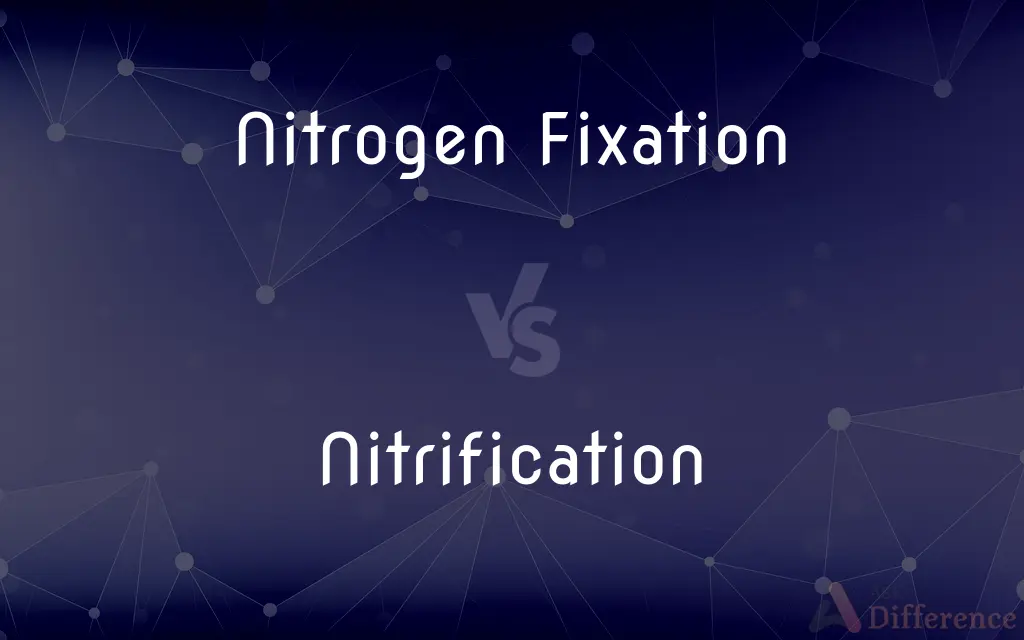Nitrogen Fixation vs. Nitrification — What's the Difference?
Edited by Tayyaba Rehman — By Fiza Rafique — Published on November 1, 2023
Nitrogen Fixation is the process of converting atmospheric nitrogen (N₂) into ammonia (NH₃), while Nitrification converts ammonia to nitrites and nitrates.

Difference Between Nitrogen Fixation and Nitrification
Table of Contents
ADVERTISEMENT
Key Differences
Nitrogen Fixation refers to the biological or physical conversion of atmospheric nitrogen (N₂) into a form usable by plants, mainly ammonia (NH₃). Nitrification, on the other hand, is a two-step microbial process that converts ammonia to nitrites (NO₂⁻) and then to nitrates (NO₃⁻).
Nitrogen Fixation plays a foundational role in the nitrogen cycle by making atmospheric nitrogen accessible to living organisms. In contrast, Nitrification further refines nitrogen's form, preparing it for either plant absorption or the next stages of the nitrogen cycle.
In nature, Nitrogen Fixation is primarily carried out by certain bacteria, including those living symbiotically with legume plants. These bacteria possess a unique enzyme, nitrogenase, which enables the fixation process. Nitrification, however, is facilitated by specific aerobic bacteria that oxidize ammonia to produce nitrites and subsequently nitrates.
Though both processes are crucial for the sustenance of ecosystems, Nitrogen Fixation and Nitrification cater to different phases of the nitrogen cycle. While Nitrogen Fixation introduces usable nitrogen into biological systems, Nitrification ensures its optimization for plant and microbial consumption.
The distinction between Nitrogen Fixation and Nitrification underscores the intricate balance and stages in the nitrogen cycle. Both processes are vital for maintaining the health and productivity of terrestrial ecosystems and aquatic systems alike.
ADVERTISEMENT
Comparison Chart
Definition
Conversion of atmospheric nitrogen to ammonia
Conversion of ammonia to nitrites and nitrates
Main Agents
Certain bacteria, including symbiotic legume bacteria
Specific aerobic bacteria
Role in Nitrogen Cycle
Introduces usable nitrogen to biological systems
Refines form of nitrogen for plant/microbial consumption
Main Biological Molecules
Nitrogenase enzyme
Oxidizing agents
Outcome
Ammonia (NH₃)
Nitrites (NO₂⁻) and Nitrates (NO₃⁻)
Compare with Definitions
Nitrogen Fixation
Atmospheric nitrogen's conversion to ammonia.
Legumes aid in Nitrogen Fixation through symbiotic relationships with bacteria.
Nitrification
Process preparing nitrogen for subsequent stages in its cycle.
Nitrification plays a pivotal role in nutrient cycling in soils.
Nitrogen Fixation
Process making nitrogen available for biological use.
Nitrogen Fixation is a vital first step in the nitrogen cycle.
Nitrification
Transformation of ammonia to nitrites and nitrates.
Nitrification ensures plants receive nitrogen in an absorbable form.
Nitrogen Fixation
Natural method of replenishing soil nitrogen.
Crop rotation often includes legumes to benefit from Nitrogen Fixation.
Nitrification
Oxidative conversion of nitrogen compounds.
Proper Nitrification can reduce the toxicity of certain aquatic environments.
Nitrogen Fixation
The biological assimilation of N₂ to NH₃.
Nitrogen Fixation enriches soil, reducing the need for synthetic fertilizers.
Nitrification
Two-step bacterial conversion in the nitrogen cycle.
Nitrification is essential for the health of both terrestrial and aquatic ecosystems.
Nitrogen Fixation
The act of rendering atmospheric nitrogen usable.
Without Nitrogen Fixation, many ecosystems would lack essential nutrients.
Nitrification
The biological oxidation of ammonia.
Wastewater treatment plants often rely on Nitrification processes.
Nitrification
To oxidize (an ammonia compound) into a nitrite or (a nitrite) into a nitrate, especially by the action of nitrifying bacteria.
Nitrification
To treat or combine with nitrogen or compounds containing nitrogen.
Nitrification
The process of nitrifying
Nitrification
The act, process, or result of combining with nitrogen or some of its compounds.
Nitrification
A process of oxidation, in which nitrogenous vegetable and animal matter in the presence of air, moisture, and some basic substances, as lime or alkali carbonate, is converted into nitrates.
Nitrification
The chemical process in which a nitro group is added to an organic compound (or substituted for another group in an organic compound)
Nitrification
The oxidation of ammonium compounds in dead organic material into nitrates and nitrites by soil bacteria (making nitrogen available to plants)
Common Curiosities
How does Nitrification differ from Nitrogen Fixation?
While Nitrogen Fixation converts atmospheric nitrogen to ammonia, Nitrification transforms ammonia into nitrites and then nitrates.
What is Nitrogen Fixation?
Nitrogen Fixation is the conversion of atmospheric nitrogen (N₂) into ammonia (NH₃) by certain bacteria.
In what environment does Nitrification occur?
Nitrification is an aerobic process, occurring in oxygen-rich environments.
What are the main agents in Nitrification?
Specific aerobic bacteria are responsible for Nitrification.
Why is Nitrogen Fixation essential?
Nitrogen Fixation makes atmospheric nitrogen accessible to plants and other organisms.
Are legumes involved in Nitrogen Fixation?
Yes, legumes have symbiotic relationships with bacteria that facilitate Nitrogen Fixation.
What role does Nitrification play in the nitrogen cycle?
Nitrification refines the form of nitrogen, preparing it for plant absorption or subsequent nitrogen cycle stages.
Can Nitrogen Fixation occur without bacteria?
While primarily facilitated by bacteria, Nitrogen Fixation can also occur through non-biological processes like lightning.
How does Nitrogen Fixation benefit agriculture?
Nitrogen Fixation enriches soils with usable nitrogen, reducing the need for synthetic fertilizers.
Share Your Discovery

Previous Comparison
Teak Wood vs. Sheesham Wood
Next Comparison
Pacific Time vs. Eastern TimeAuthor Spotlight
Written by
Fiza RafiqueFiza Rafique is a skilled content writer at AskDifference.com, where she meticulously refines and enhances written pieces. Drawing from her vast editorial expertise, Fiza ensures clarity, accuracy, and precision in every article. Passionate about language, she continually seeks to elevate the quality of content for readers worldwide.
Edited by
Tayyaba RehmanTayyaba Rehman is a distinguished writer, currently serving as a primary contributor to askdifference.com. As a researcher in semantics and etymology, Tayyaba's passion for the complexity of languages and their distinctions has found a perfect home on the platform. Tayyaba delves into the intricacies of language, distinguishing between commonly confused words and phrases, thereby providing clarity for readers worldwide.
















































